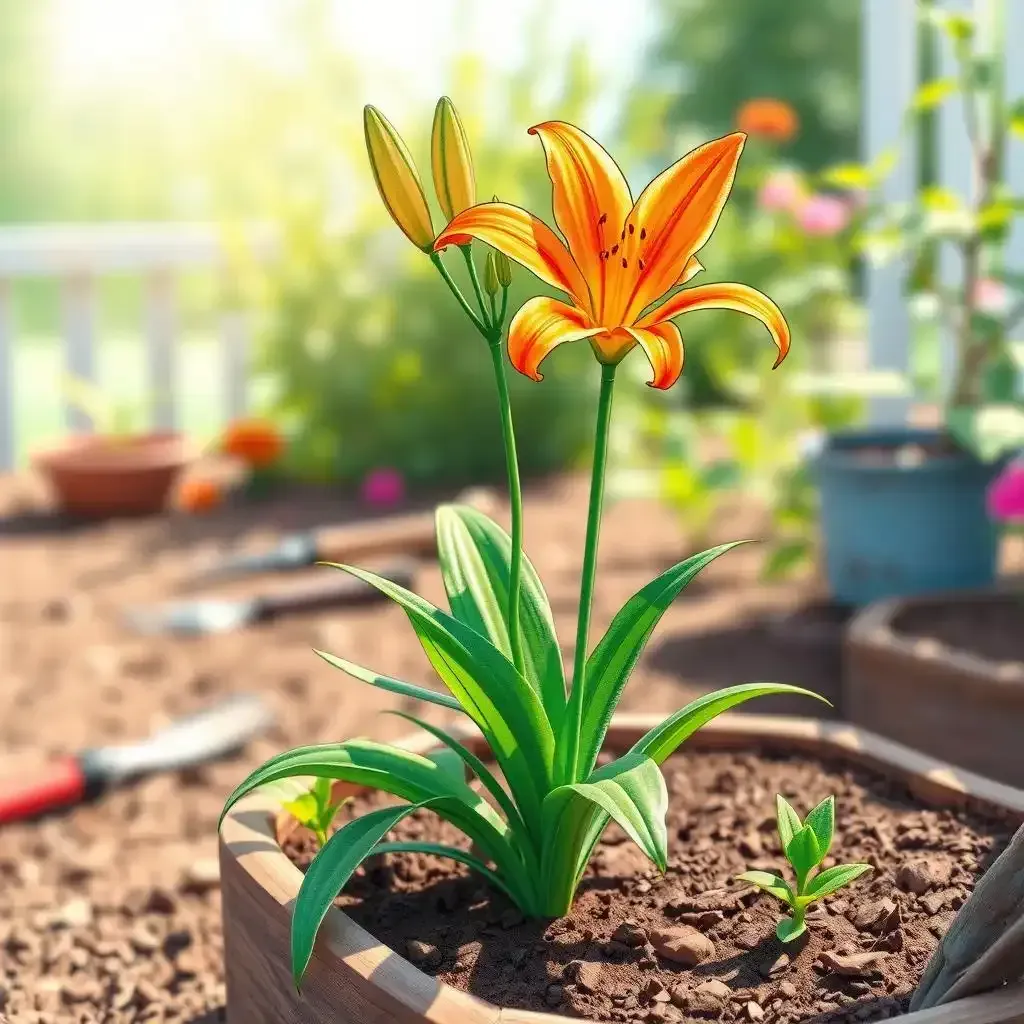Table of Contents
So, you're ready to add the striking beauty of tiger lilies to your garden? Fantastic! These vibrant blooms, with their speckled orange and black petals, are a real showstopper. But knowing when to plant tiger lilies is key to their success. Planting at the wrong time can mean weak plants, fewer flowers, or even failure to bloom at all. This comprehensive guide from lilyflower.homes will walk you through everything you need to know about planting tiger lilies, ensuring your garden explodes with these stunning beauties. We'll cover the ideal planting times, the best soil conditions, and even offer tips for troubleshooting common problems. Get ready to transform your garden with the fiery elegance of tiger lilies!
When Should I Plant Tiger Lilies: Understanding the Ideal Timing

When Should I Plant Tiger Lilies Understanding The Ideal Timing
Spring Planting: A Burst of Color
Hey there, fellow plant enthusiasts! Let's talk about the best time to plant tiger lilies. Spring is the perfect time, especially after the last frost. Think of it like this: tiger lilies are like sleepy lions, they need the ground to warm up a bit before they wake up and start growing. Planting them too early, when the soil's still chilly, is like sending them to a winter camp. They'll be grumpy and slow to grow. Aim for a time when the soil is workable and consistently above 50°F (10°C). You want the earth to be warm and inviting, not cold and unfriendly! I usually wait until after all chances of frost are gone in my area. This ensures the delicate tiger lily sprouts aren't zapped by a late frost. Check your local weather forecast – it’s your best friend in this game!
Month | Action | Things to consider |
|---|---|---|
March-April (depending on your location) | Prepare soil and planting area | Check soil drainage, amend if needed. |
Late April-May | Plant tiger lily bulbs | Space bulbs appropriately, follow instructions on your bulb package. |
May-June | Water regularly | Especially during dry spells. |
Autumn Planting: A Head Start for Spring
Now, here’s a clever trick: you can also plant tiger lilies in autumn! This gives the bulbs a head start, allowing them to establish strong roots before winter sets in. It's like giving them a cozy winter slumber party, so they're raring to go when spring arrives. Autumn planting usually takes place in September or October, after the soil has cooled down but before the ground freezes solid. Again, your local climate is key; too early, and they might start growing too soon and get frostbitten. Too late, and they might not have time to root properly. Imagine planting them when the leaves start to turn – it’s a beautiful time to get your hands dirty! For more beautiful tiger lily images, check out our gallery of amazing tiger lily images. For a more artistic take, we also have this stunning painting to inspire you.
- Choose a sunny spot with well-drained soil.
- Plant bulbs about 6 inches deep and 6 inches apart.
- Water well after planting.
Tiger Lilies Planting Guide: Soil, Location, and Aftercare

Tiger Lilies Planting Guide Soil Location And Aftercare
Okay, so you've figured out *when* to plant your tiger lilies – fantastic! Now let's talk about *where* and *how*. Think of your tiger lilies as picky eaters; they don't just want *any* spot in your garden. They crave a sunny spot, like a little patch of heaven bathed in sunlight. At least six hours of direct sun a day is ideal. Less than that, and you might end up with leggy, unhappy lilies. Imagine them stretching and yearning for more sun, like toddlers reaching for a dropped ice cream cone! They also need well-drained soil. Soggy feet are a no-no for these beauties; they'll rot faster than a forgotten banana. Think of it like this: you wouldn't want to stand in a puddle all day, would you? Your tiger lilies feel the same way. Amend heavy clay soils with compost or other organic matter to improve drainage. For some gorgeous inspiration, check out our gallery of amazing tiger lily images.
Soil Type | Ideal Conditions | What to do |
|---|---|---|
Sandy | Well-draining, but can dry out quickly | Add organic matter to retain moisture |
Clay | Poor drainage, heavy | Amend with compost or perlite to improve drainage |
Loamy | Generally good drainage and moisture retention | Perfect! |
Once you've found the perfect sunny spot with well-drained soil, it’s time to plant! Dig holes about six inches deep, spacing the bulbs about six inches apart. This gives them enough room to grow without overcrowding. After planting, water them gently but thoroughly. Don't drown them, but make sure the soil is moist. Regular watering, especially during dry spells, is essential, especially in the first few weeks after planting. Think of it like this: you wouldn't leave a newborn baby unattended, would you? Your tiger lilies need a little TLC too. For more tips on caring for your tiger lilies, check out this stunning guide on tiger lilies. It's full of beautiful pictures and helpful advice!
- Water deeply but infrequently.
- Mulch around the plants to retain moisture and suppress weeds.
- Fertilize lightly in spring with a balanced fertilizer.
Aftercare is pretty straightforward. Keep an eye out for pests and diseases. Snails and slugs are particularly fond of tiger lilies, so you might need to take some preventative measures. Think of it as a tiny battle between you and the garden pests! You'll need to protect your precious lilies from these hungry critters! Also, deadhead spent flowers (remove the wilted blooms) to encourage more blooms and prevent seed production which can sap the plant’s energy. Deadheading is like giving your lilies a little haircut – it keeps them looking neat and tidy and encourages more flowers. For more creative ideas, check out our post on making amazing tiger lily sugar flowers!
"The best time to plant a tree was twenty years ago. The second best time is today." - A wise gardener (probably)
Remember, even with the best care, some tiger lilies might not bloom the first year. They need time to establish themselves. Be patient, and they'll reward you with their vibrant beauty in the years to come. Thinking about the symbolism of tiger lilies? Check out our guide on the pink tiger lily flower meaning, which is full of interesting insights. It might just surprise you!
Troubleshooting Tiger Lily Planting: Common Problems and Solutions

Troubleshooting Tiger Lily Planting Common Problems And Solutions
So, you've planted your tiger lilies, following all the advice (hopefully!), and now you're waiting for those glorious blooms. But what if things don't go exactly to plan? Don't panic! I've been there, and let me tell you, even experienced gardeners face challenges. One common issue is pests. Slugs and snails are notorious for munching on tender tiger lily leaves. Think of them as tiny, slimy garden ninjas! To combat these villains, you can use slug pellets (following the instructions carefully!), beer traps (they're weirdly effective!), or even hand-pick them at night. It’s like a little garden game, but you're the winner!
- Use slug pellets or beer traps.
- Hand-pick slugs and snails at night.
- Consider diatomaceous earth as a natural deterrent.
Another problem is diseases. Botrytis blight is a fungal disease that can cause brown spots on leaves and rot on bulbs. Good air circulation around the plants helps prevent this; think of it as giving your lilies some breathing room. If you see signs of disease, remove affected leaves and bulbs promptly, and consider using a fungicide as a last resort. Check out our guide on stunning tiger lilies for more information on keeping them healthy. Sometimes, your lilies might not bloom the first year; it's not a sign of failure. They need time to settle in, like a new kid in school. Be patient; they'll reward you eventually with their vibrant flowers.
Problem | Cause | Solution |
|---|---|---|
Slugs and snails | Hungry pests | Use slug pellets or beer traps |
Botrytis blight | Fungal disease | Improve air circulation, remove affected parts |
No blooms first year | Plants need time to establish | Be patient! |
Sometimes, your tiger lilies might not thrive because of poor soil drainage. Remember, soggy feet are a big no-no for these beauties. If you notice yellowing leaves or wilting, it might be a sign of poor drainage. Amending the soil with compost or other organic matter can significantly improve drainage. This allows the water to drain away, preventing root rot. You can also improve drainage by creating raised beds. This gives your plants a little extra height, helping them avoid sitting in water. For some gorgeous inspiration, check out our gallery of . You can learn more about soil types and how to improve them in our article on tiger lilies.
"Gardening is cheaper than therapy, and you get potatoes." - Unknown wise gardener
Finally, remember that the location also plays a crucial role in your lilies' happiness. Insufficient sunlight can lead to weak growth and fewer flowers. If your lilies are struggling, consider moving them to a sunnier spot. Six hours of sunlight is ideal. If you're struggling with the placement, consider our guide on the meaning of tiger lilies – it might offer some inspiration! And while we're at it, why not check out our amazing step-by-step guide on drawing tiger lilies? It's a fun project for a rainy day.
- Check for pests and diseases regularly.
- Ensure adequate sunlight and water.
- Amend soil if necessary.
Final Thought
Planting tiger lilies successfully hinges on understanding their needs and timing. By following the advice given here, you can increase your chances of enjoying a spectacular display of these captivating flowers. Remember, patience and attention to detail are crucial. Happy gardening!